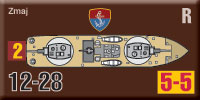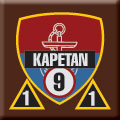| Blue Danube:
Unhappy Serbia
By Mike Bennighof, Ph.D.
January 2022
Note: The Second Great War is our alternative history setting in which the First World War ended with a negotiated peace that allowed the great empires – Austria-Hungary, Germany, Russia and Ottoman Turkey – to survive for another generation’s war. Our Second Great War at Sea books tell the story and present new scenarios from this war that never happened waged by fleets that never were. River Battleships: Blue Danube is a unique crossover: a special Gold-Club-exclusive expansion for Panzer Grenadier: River Battleships that extends the Second Great War story line into the heart of southeastern Europe, and adds more river battles to Panzer Grenadier.
Serbia emerged from the First Great War fortunate to exist at all; during the negotiations that led to Wilson’s Peace the Germans pressed their Austrian allies to demand the kingdom’s outright annexation but the Austrians feared the expense in blood and treasure of a decades-long hostile occupation. Not even the Russians were willing to scuttle the peace talks on behalf of Serbia’s terrorist regime, but Woodrow Wilson insisted on popular votes regarding the future of both Serbia and its neighboring regions.
For the most part, the voting went against the Serbian nationalists. The Muslim majority of Novi Pasar, a small corridor between Serbia and Montenegro that the Serbs had annexed in 1908, voted to rejoin Bosnia. Kosovo returned to Albania, while Macedonia opted for union with Bulgaria. A few districts of northeastern Bosnia voted to join Serbia, but the resulting Serb state was even smaller than the Kingdom of Serbia at the turn of the century. More Serbs live within the Habsburg Monarchy than inside Serbia proper.
 Austrian and Bulgarian occupation troops left Serbia in March 1917, and within days armed bands of komatadji guerillas began to infiltrate over the borders into Bosnia, Macedonia and southern Hungary. The resulting atrocities enraged the Austrian public and – as intended - almost destroyed the peace process. But Austria’s new Emperor Karl overruled the generals urging the destruction of Belgrade, the Serbian capital situated right across the river Danube from Austrian territory, through artillery fire. The Dual Monarchy would have peace, Karl declared, but it would not be made a victim. Both Austria and Bulgaria lined their borders with watchtowers, barbed wire and a cordon of troops, stopping the attacks but also preventing any resumption of trade. Austrian and Bulgarian occupation troops left Serbia in March 1917, and within days armed bands of komatadji guerillas began to infiltrate over the borders into Bosnia, Macedonia and southern Hungary. The resulting atrocities enraged the Austrian public and – as intended - almost destroyed the peace process. But Austria’s new Emperor Karl overruled the generals urging the destruction of Belgrade, the Serbian capital situated right across the river Danube from Austrian territory, through artillery fire. The Dual Monarchy would have peace, Karl declared, but it would not be made a victim. Both Austria and Bulgaria lined their borders with watchtowers, barbed wire and a cordon of troops, stopping the attacks but also preventing any resumption of trade.
As Serbian standards of living dropped below those of her neighbors, the royal government responded with its own isolationist policies to tamp down dissent; private ownership of a radio, for example, is punishable by ten years of hard labor. Schools teach children to glorify the Serb nation and its holy mission to liberate all Slavic peoples, and publishers are forbidden to print German or Croatian texts. Even the use of the Latin alphabet in advertising is a crime. Foreign travel is nearly impossible and coffee is outlawed due to its Turkish cultural connotations, but opiate-laced cigarettes are given a heavy government subsidy.
Serbia is a very unhappy place.
 Boycotted by her neighbors, and returning their scorn with interest, Serbia could only export her wares – chiefly pigs and plum brandy – down the Danube through Romania to Russia. With a bitter king anxious to overturn Wilson’s Peace, backed by a bitter parliament and government even more eager to renew the war, Serbia spent the decade and a half after the First Great War impotently spewing hatred toward all things Austrian (and to a lesser extent, German, Bulgarian, Turkish and Croatian). The Serb rump state that remained after 1917 could not support its own budget without Russian cash subsidies, let alone build the modern armed forces necessary to challenge the Habsburgs. For years vengeance remained confined to terrorist plots and military dreams. Boycotted by her neighbors, and returning their scorn with interest, Serbia could only export her wares – chiefly pigs and plum brandy – down the Danube through Romania to Russia. With a bitter king anxious to overturn Wilson’s Peace, backed by a bitter parliament and government even more eager to renew the war, Serbia spent the decade and a half after the First Great War impotently spewing hatred toward all things Austrian (and to a lesser extent, German, Bulgarian, Turkish and Croatian). The Serb rump state that remained after 1917 could not support its own budget without Russian cash subsidies, let alone build the modern armed forces necessary to challenge the Habsburgs. For years vengeance remained confined to terrorist plots and military dreams.
That changed in the mid-1930’s, when Imperial Russia’s startling economic growth allowed not only a thorough update of the Tsar’s forces, but substantial aid to his allies as well. New Russian-made tanks, aircraft and artillery flowed up the Danube and into King Alexander’s arsenals, while Russian officers arrived to train the Serbs in their use. Russian officers took control of Serbian communications facilities as well, to make sure that a new war would break out when the Tsar wished, and not any earlier.
Along with this bounty of aid for Serbia’s badly outdated land and air forces, the Russians also laid down a series of powerful river warships for the Royal Serbian Danube Flotilla at the huge naval shipyard complex in Nikolayev. Designed by Russian naval architects and built in a Russian shipyard, they were initially crewed by Russians as well. By 1940 most of the enlisted men had been replaced by Serbs, except for a few gunnery and engineering specialists, but most of Serbia’s large riverine warships still had a Russian commander and executive officer.
 With Austria still wielding a formidable river fleet, Russian strategists consider it crucial for Serbia to counter this brown-water power with her own flotilla. The only possible supply line to Serbia runs from Romania along the Danube, either on the river itself or on the rail line along its banks. The Austrians can’t be allowed to force their way down the big river to the Iron Gates, which would leave Serbia completely isolated. The Imperial Russian general staff sees Serbia as a vital bridgehead deep inside Central Powers territory, with an important role to play in the coming offensive. And so they’ve provided Serbia with a river fleet to meet that strategic need. With Austria still wielding a formidable river fleet, Russian strategists consider it crucial for Serbia to counter this brown-water power with her own flotilla. The only possible supply line to Serbia runs from Romania along the Danube, either on the river itself or on the rail line along its banks. The Austrians can’t be allowed to force their way down the big river to the Iron Gates, which would leave Serbia completely isolated. The Imperial Russian general staff sees Serbia as a vital bridgehead deep inside Central Powers territory, with an important role to play in the coming offensive. And so they’ve provided Serbia with a river fleet to meet that strategic need.
Serbia’s largest monitors are the three large boats of the Zmaj class, built at Nikolayev just before the war and displacing about 900 tons. Designed chiefly for artillery support of river-crossing operations, they feature a pair of 180mm (7.1-inch) guns in single turrets fore and aft, plus some anti-aircraft weaponry. They are well-protected, as river craft go, and as the most powerful warships in the Serbian inventory also have the largest contingents of Russian advisors.
 The slightly older and smaller Nesreha class are also Russian-designed and -built, coming down the ways at Nikolayev in the mid-1930’s. They feature a mix of firepower, with a pair of dual Swedish-made 40mm anti-aircraft mounts aft, also deadly against “soft” targets on the river or its banks, and a single high-velocity 127mm (4.7-inch) gun mounted forward in an armored turret. They are designed to fight the Austrian river flotilla, with powerful anti-armor weaponry to sink or drive off enemy monitors and heavy automatic firepower to deal with smaller craft. The slightly older and smaller Nesreha class are also Russian-designed and -built, coming down the ways at Nikolayev in the mid-1930’s. They feature a mix of firepower, with a pair of dual Swedish-made 40mm anti-aircraft mounts aft, also deadly against “soft” targets on the river or its banks, and a single high-velocity 127mm (4.7-inch) gun mounted forward in an armored turret. They are designed to fight the Austrian river flotilla, with powerful anti-armor weaponry to sink or drive off enemy monitors and heavy automatic firepower to deal with smaller craft.
In addition to its Russian-built river warships, Serbia built its own series of much smaller river gunboats. Each carries a dual 40mm mount and light armor; in peacetime they serve as part of the Serbian border guard establishment but are transferred to the river flotilla on the outbreak of war.
Supporting Serbia’s river flotilla is a brigade-sized Marine Corps, well-trained by Russian advisors and armed with the most modern Russian weaponry. These ground forces are expected to fight in amphibious landings, to guard bridgeheads, and if necessary to engage in boarding operations on the river.
Serbia’s participation in the Second Great War was never a question; her dynasty, government and military – though not all of her people – have burned for renewed war since the moment the last war ended. The only question has been when the Tsar would unleash his small but fanatic ally. That signal came in August 1940, when Imperial Russian tanks and aircraft stormed into Poland.
Don’t wait to put Blue Danube on your game table! Join the Gold Club and find out how to get it!
Sign up for our newsletter right here. Your info will never be sold or transferred; we'll just use it to update you on new games and new offers.
Mike Bennighof is president of Avalanche Press and holds a doctorate in history from Emory University. A Fulbright Scholar and NASA Journalist in Space finalist, he has published an unknowable number of books, games and articles on historical subjects.
He lives in Birmingham, Alabama with his wife, three children and his dog, Leopold.
Want to keep Daily Content free of third-party ads? You can send us some love (and cash) through this link right here.
|
